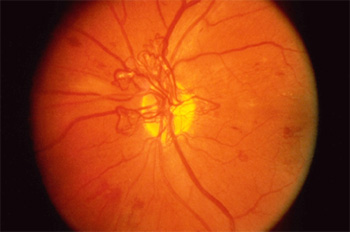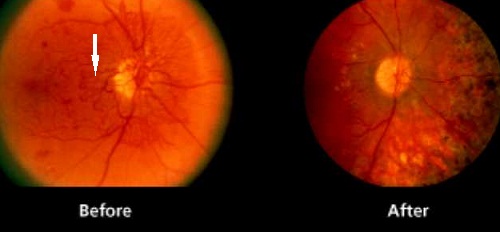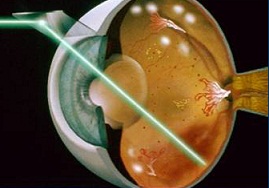Why is retinal laser necessary?
Pan-retinal photocoagulation laser is performed for patients who have developed abnormal new blood vessels (neovascularization) in their eyes. The purpose of PRP laser is to prevent the abnormal new blood vessels from growing and causing loss of vision.

These abnormal new blood vessels initially grow on the retina (the inner lining of the eye) as a response to the retina being starved of blood and oxygen.
When neovascularization occurs as a result of diabetes, it is called proliferative diabetic retinopathy (PDR).
Neovascularization can also occur due to any disease that reduces the amount of blood flow and oxygen to the eye (such as retinal vein occlusion).
Neovascularization causes visual loss in three ways:
- Bleeding into the back cavity of the eyeball (vitreous hemorrhage).
- Formation of scar tissue that subsequently causes the retina to become peeled away from the wall of the eye (tractional retinal detachment).
- Formation of scar tissue at the front of the eye, causing high eye pressure and damage to the optic nerve (neovascular glaucoma).
What does retinal laser do?
When the cells in the retina are starved of blood and oxygen, they become ischemic and release chemicals that stimulate the growth of the abnormal new blood vessels.
PRP laser coagulates the ischemic retinal cells, thus effectively ‘killing’ these cells. These retinal cells die and as a result, the chemicals that stimulate and promote neovascularization are no longer produced.
This prevents further abnormal new blood vessels from growing, and may cause any existing abnormal vessels to shrink or even disappear completely.
Please note that pan-retinal photocoagulation laser is not laser vision correction and therefore does not improve your vision.

What are the potential risks?
Pan-retinal photocoagulation laser is generally safe. Risks include:
- Loss of peripheral vision. This is common, and is due to PRP laser coagulating the cells of the retina that give you peripheral vision. If extensive PRP laser needs to be performed to both eyes, this may reduce your visual field to the extent that you are no longer eligible to drive safely.
- Loss of central vision due to erroneous PRP laser to the macula. This is very rare.
- Fluid at the central part of the retina (macular edema).
- Inflammation in the eye.
- Detachment of the retina. This can be treated with retinal detachment surgery (vitrectomy).
- Scratch on the front window of the eye (cornea).
What should I expect?
Pan-retinal photocoagulation laser is an office-based procedure, and does not require sedation or hospital admission.
Before laser:
On the day of your procedure, please take all your usual medications unless otherwise advised. You will not be able to drive home on the day of the procedure, so you will need to arrange for someone to take you home. Please allow at least 2 hours.
Before the laser procedure, 2 types of eye drops will be put in the eye undergoing laser:
- Drops to enlarge the pupil. These can take up to 30 minutes to work.
- Local anesthetic to numb the eye.
During laser:
PRP laser is usually performed with the patient seated at the laser machine. The laser is delivered through a special contact lens that is placed on the front of the eye.
You will notice some flashing lights and may feel some discomfort with the laser shots during the procedure. The discomfort may increase in intensity if the laser power needs to be increased.
Each PRP laser session takes around 10 to 15 minutes to perform.

After laser:
Usually no eye drops are required after laser. However if there is inflammation after laser, you may be given a steroid anti-inflammatory eye drop (usually Fluorometholone) to use 3 times daily for 1 week.
Over the next few days, you may experience some blurriness, irritation, and sensitivity to light. This will gradually improve without any treatment.
You will usually be reviewed 4 to 6 weeks after completion of the course of PRP laser.
Learn more about other laser treatments for diabetic retinopathy


